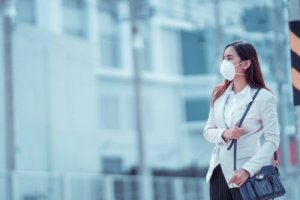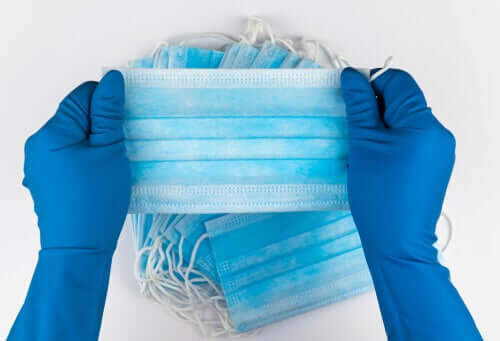Types of Masks to Protect Against Coronavirus


Written and verified by the doctor Leonardo Biolatto
The COVID-19 strain of the coronavirus continues its path of dispersion throughout the world, and the World Health Organization has now categorized it as a pandemic. This has had an influence on the types of masks that are on the market and people have comes to use them massively.
What’s certain is that a great deal of incorrect information circulates on the internet about these devices. Unfortunately, the general population’s panic has caused them to sell out in stores. Similarly, we see people on the street wearing masks, but they’re often using them improperly.
From the beginning, recommendations regarding the type of masks people should use have always existed. The same is true regarding who should use them. Similarly, the public’s sense of urgency has overcome the spread of scientific information and, in some countries, the application of protocols has taken too long.
In this article, we’re going to tell you about the different masks that are available. What’s more, we’ll tell you who should use them and what recommendations exist regarding their use.
Types of masks to protect against coronavirus
We know that the COVID-19 virus spreads through the air by way of drops that infected people expel from their mouths and noses. This is known as aerosol transmission, and it’s logical to suppose that wearing a mask can be helpful.
However, for coronavirus as well as other similarly transmitted pathologies, like the flu, not every mask has the same effect. Here, the microscopic size of the virus and the particles that transport it both play a very important role.
Basically, there are two general types of masks: Surgical masks and filtering masks. Among this second type, there are three different models that differ according to the size of their filters.
Let’s take a look at them.
Surgical masks, one of the most common types of masks
This is the most classic type of mask and they owe their name to their use in operating rooms. For the same reason, their purpose isn’t to stop the transmission of viruses, but rather to protect against the splattering of fluids. Surgeons and medical personnel wear them so that their patients’ blood doesn’t get into their mucous membranes, for example.
The barrier they create is physical, but the WHO has always pointed out that they have no effect when it comes to preventing contagion. Using them against COVID-19 while in public is more of a placebo for users than an actual preventative measure.
Filter mask
These devices are more complex than surgical masks. They contain a filter in the front that doesn’t allow certain particles to pass from their exterior to their interior. A rating system determines that level, or grade, or each filter:
- Grade 1: Known technically as FFP1 or P1, these are the least effective filter masks when it comes to protecting against infectious aerosols. In practice, their purpose is to filter out inert particles, such as brick dust in construction.
- Grade 2: FFP2 or P2 masks are a type of protection that filters ups to 92% of circulating particles, allowing a maximum of 8% to pass through. The WHO recommends using a filter or at least 95% against coronavirus. Therefore, these masks are right on the limit of this organization’s recommendations.
- Grade 3: Finally, FFP3 filter masks only allow 2% of circulating particles to pass through to their interior.

Keep reading: Common Myths about Coronavirus
Who should use masks during the coronavirus pandemic?
It’s not enough to know which masks are effective in preventing the spread of COVID-19 and which are not. You also need to know which situations merit their use and which do not. Clearly, if everyone goes out all the time with surgical masks, this will be ineffective. So, keep the following in mind regarding who should use masks:
- Those who arrive from an area with high transmission of the virus. This is even more important for persons who display symptoms that are compatible with coronavirus (fever, dry cough, fatigue, etc.). These individuals should wear a mask for a least 14 days, which is the calculated incubation period.
- In health facilities, both medical professionals that attend suspected cases, as well as patients with symptoms that are not in isolation should wear masks. What’s more, patients that are in awaiting a consult in waiting rooms should also wear masks.
As we’ve explained before, these people should use the types of masks that are effective and not just any mask. In other words, they should use FPP3 masks or, if one of these is not available, then FFP2 maks.
On top of using masks, people should still add other recommended preventative measures. These include:
- Frequent handwashing with soap and water.
- Isolation or quarantine if the situation calls for it.
- The general hygiene of utensils and surfaces.
Remember that the use of masks alone is not enough.

Discover more: 5 Home Exercises for the Coronavirus Quarantine
Final recommendations of the use of masks to prevent the spread of coronavirus
As we’ve explained, if you require a mask, then you should choose one with a filter that’s FFP2 standards or higher, according to the WHO. Remember, not everyone needs to wear a mask. Those who are traveling to high transmission areas and those who suspect they may have the virus should wear them. Of course, health professionals should wear them as well.
The mask should correctly cover your nose and mouth. When it comes to removing your mask, you should remove it from the back. If you grab the front of the mask, then all you’ve done to protect yourself will have been in vain. In the same way, you should not touch the mask while you are wearing it.
If your mask becomes wet while you are using it, then it loses its ability to filter. Once you are finished using a mask, you should dispose of it. You should never reuse a filter mask.
All cited sources were thoroughly reviewed by our team to ensure their quality, reliability, currency, and validity. The bibliography of this article was considered reliable and of academic or scientific accuracy.
- Izquierdo, Laura Díez. INFORME TÉCNICO Nuevo coronavirus 2019-nCoV. Diss. Instituto de Salud Carlos III, 2020.
- World Health Organization. “Novel Coronavirus (2019-nCoV) technical guidance.” (2020).
- Mayo Montero, MªE, et al. “Prevención y control de la infección ante sujetos sospechosos de infección por el nuevo coronavirus MERS-CoV en Unidades militares.” Sanidad Militar 71.3 (2015): 196-200.
- Ramos, Celso. “Covid-19: la nueva enfermedad causada por un coronavirus.” salud pública de méxico 62.2, Mar-Abr (2020): 225-227.
This text is provided for informational purposes only and does not replace consultation with a professional. If in doubt, consult your specialist.








